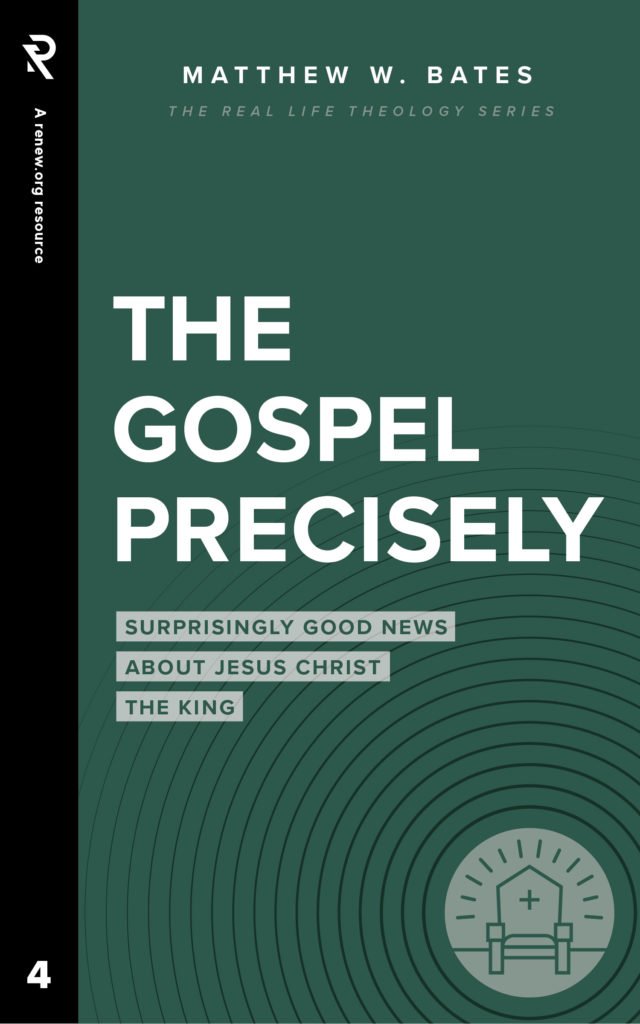
The Earliest Creeds in Christianity & What Conclusion They Point To
What are the earliest creeds in Christianity? There are church creeds such as the Nicene Creed (A.D. 325) and the Chalcedonian Creed (A.D. 451), but the earliest creeds go back much farther—to even before the writing of the New Testament. Within the New Testament writings (all written within the first century A.D.), we find creedal material that the authors quoted from. Some examples of these gospel sayings and hymns from the early church are found in Romans 1:3-4; Romans 10:9; 1 Corinthians 12:3; 2 Corinthians 13:13; and Philippians 2:6-11, to name a few. What do these earliest creeds teach? What conclusion do they point to?
The creedal material embedded in the New Testament predates the texts they are in. Using these creeds served a dual purpose for the authors: First, it reminded the original audience of teachings and traditions they had received orally. For example, consider Paul’s reminder to the Corinthian church, as he points them to an early gospel saying:
“Now, brothers and sisters, I want to remind you of the gospel I preached to you, which you received and on which you have taken your stand. By this gospel you are saved, if you hold firmly to the word I preached to you. Otherwise, you have believed in vain.
For what I received I passed on to you as of first importance: that Christ died for our sins according to the Scriptures, that he was buried, that he was raised on the third day according to the Scriptures, and that he appeared to Cephas, and then to the Twelve. After that, he appeared to more than five hundred of the brothers and sisters at the same time, most of whom are still living, though some have fallen asleep. Then he appeared to James, then to all the apostles, and last of all he appeared to me also, as to one abnormally born.” (1 Cor. 15:1-8, NIV)
Second, it confirmed the author’s written word by showing continuity with this previously received kerygma. (Kerygma is a Greek word meaning proclaiming or preaching, and in this context, it refers to the early gospel message that was proclaimed and enshrined in these early creedal sayings.)
Earliest Creeds in Christianity: “The creedal material embedded in the New Testament predates the texts they are in.”
The Critics and the Creeds
Several biblical critics holding a low view of Scripture and traditional orthodox Christian beliefs readily concede that the New Testament corpus includes an abundant amount of such creedal material. However, they fail to follow the evidence to its logical conclusion; namely that the earliest Christian communities were unified in their core beliefs and such unified beliefs existed from the earliest temporal strata of the movement.
By failing to seriously consider the early and consistently unified nature of such New Testament creeds, those espousing negative theories regarding the veracity of the gospel and orthodox Christianity render themselves less convincing and more incoherent than moderate and conservative scholars.
Earliest Creeds in Christianity: “The earliest Christian communities were unified in their core beliefs and such unified beliefs existed from the earliest temporal strata of the movement.”
This article features several negative higher critics of the New Testament, readily conceding the existence of creeds, hymns and kerygmatic traditions predating the New Testament texts. Secondly this article then highlights weaknesses of negative higher critical conclusions in light of such concessions. In conclusion, the early and unified nature of New Testament creeds shall emerge, producing a strong apologetic case for an orthodox Christianity.
Bart Ehrman and the Earliest Christian Creeds
It’s important to reiterate that numerous original canonical documents contain an abundance of kerygmatic and creedal data predating the texts themselves. Such data shares a commonality centered on the events of the gospel and focused upon the nature of God the Father and the Lord Jesus Christ.
Yet, instead of admitting the most likely conclusion that such core commonality points to one unified source (i.e., Jesus’ apostles in Jerusalem), Ehrman prefers to focus on alleged discrepancies surfacing due to much later textual variants, variants which would not have existed in the originals. Yet even Ehrman concedes the creedal and kerygmatic nature of these pre-textual passages.[1] Several examples of Ehrman’s concession surface in his following works.
“Instead of admitting the most likely conclusion that such core commonality points to one unified source, Ehrman prefers to focus on alleged discrepancies surfacing.”
In his book Forged, Ehrman argues that “the ancient religions were almost never interested in ‘true beliefs’…the polytheistic religions of the vast majority of people in the ancient world, who were neither Jewish nor Christian—did not have creeds that had to be recited, beliefs that had to be affirmed, or scriptures that had to be accepted as conveying divine truth.”[2] Ehrman’s mentioning of Jews and Christians in fact highlights their uniqueness against the backdrop of largely non-doctrinal Pagan faiths.
Essentially, his observation works against his argument, rather than for it. Jews and Christians, who did boast such creeds, beliefs, and scriptures stood apart from rather than underneath the umbrella of such Pagan religions. Ehrman continues in this section with the questionable thesis that all ancient religions did not concern themselves with truth and that truth reserved itself for the realm of philosophy. Even if this were the case among Pagan religions, it does not therefore follow that the Judeo-Christian faith did not concern itself with the concept of truth. Even a cursory read of the Bible dispels such absurdity.
In his work Did Jesus Exist?, Ehrman grounds the historical Jesus “in Jewish circles in Palestine,” readily dating historical knowledge of him “in the 30s of the first century.”[3] The obvious question becomes why he then argues from Pagan beliefs and teachings—or lack thereof—in order to undermine the biblical portrayal of Jesus.
In response to the groundless notion that Jesus never existed, even Ehrman cites “a number of surviving Gospels…independent in a large number of their traditions” which “corroborate many of the same basic sets of data—for example, that Jesus…was a Jewish teacher who was crucified by the Romans at the instigation of Jewish authorities in Jerusalem.”[4]
Even Ehrman cites “a number of surviving Gospels…independent in a large number of their traditions” which “corroborate many of the same basic sets of data.”
Ehrman also recognizes numerous Gospel texts founded on “oral traditions…in circulation for years among communities of Christians in different parts of the world, all…attesting to the existence of Jesus…some of these traditions…originated in Aramaic-speaking communities of Palestine, probably in the 30s CE, within several years…of Jesus.”[5]
With essentially no evidence to back his skepticism, Ehrman imagines the existence of traditions containing a less-than-divine Jesus. Virtually assuming his conclusion in his premise and lacking solid evidence, he refers to such traditions as “probably the oldest Christian traditions.”[6]
Nevertheless, he readily admits and identifies several commonly accepted creedal passages and their pre-literary nature. He even agrees with most scholars that Paul’s inclusion of one such kerygmatic passage to the Roman Church (i.e., Romans 1:3-4) was done so in order to gain rapport with an otherwise unknown group of Christians. Yet instead of recognizing the shared beliefs between the Roman Christians and Paul, he falsely concludes that Paul did not hold such beliefs precisely.
Rudolf Bultmann and the Earliest Christian Creeds
Another well-known skeptic of the biblical portrait of Jesus who concedes creedal and kerygmatic material within the New Testament texts is the late Rudolf Bultmann. In his first volume of New Testament Theology, he readily and consistently recognizes a plethora of pre-textual traditions (παράδοςις and homologia) within the New Testament.
When commenting on 1 Corinthians 15:3-ff., Bultmann points to the phrase κατά τάς γραφάς—otherwise not used of Paul—as evidence of this creed not originating with Paul.[7] In other words, Paul is not the origin of this material. A bit further in this bulwark of theology, he correctly ties Peter’s sighting of Jesus resurrected in 1 Corinthians 15:5 with Luke 24:34, another passage regarded by many as a pre-textual creed, albeit brief.[8]
Earliest Creeds in Christianity: “Bultmann readily and consistently recognizes a plethora of pre-textual traditions within the New Testament.”
When addressing Romans 1:3-4 and the title “Son of David,” he wrote that “Paul must have found it in…use before him. For though the title is of no importance to him, he refers to it in Rom. 1:3, a sentence which is…a handed-down formula; he desires thereby to accredit himself to the unknown Roman Church as an apostle who advocates right doctrine.”[9]
He also insists that “the Pauline letters indicate that in the Hellenistic Church Jesus was called ‘Lord’ Κύριος and was actually worshiped,”[10] and he concedes that the eschatological prayer “Maranatha” (Our Lord come!) in 1 Cor. 16:22 “certainly comes out of the earliest Church, but it likewise is no proof that the earliest Church invoked Jesus as Lord; for it can originally have meant God, even if it was later taken to refer to Jesus (Rev. 22:20).”[11]
Of Romans 10:9, Bultmann penned, “That God raised him from the dead is a statement that, obviously quite early, was a constituent of more or less crystallized creedal statements, for without doubt Paul is alluding to a creedal formula in Rom. 10:9.”[12] Overall Bultmann identified the confession “Jesus is Lord” as not having originated with Paul yet incorporated in such passages as Rom. 10:9, 1 Cor. 12:3 and the Christ hymn of Phil. 2:6-11.
Earliest Creeds in Christianity: “Bultmann identified the confession ‘Jesus is Lord’ as not having originated with Paul.”
Yet, in spite of recognizing Paul as the earliest New Testament author as well as the abundance of pre-textual kerygmatic formulas embedded within his and other canonical texts, Bultmann somehow manages to pinpoint early exaltations of Jesus Christ on Hellenism. The following section will address this in more detail.
Gerd Lüdemann and the Earliest Christian Creeds
A third negative higher critic of canonical Scripture and the orthodox portrait of Jesus Christ pertinent to this study is Gerd Lüdemann. In a pattern similar to Ehrman and Bultmann, Lüdemann also affirms the pre-textual nature of many kerygmatic and creedal passages while not taking seriously the implications of their uniform and early nature.
Lüdemann recognizes regarding Romans 1:3 that, for Paul, Jesus’ birth under the law served as a central feature of his theology.[13] He connects Paul’s understanding of baptism to the resurrection (Rom. 6:3-4). Here he concedes that this passage likely rests on a pre-Pauline origin (einen vorpaulanischen Ursprung gehabt haben). This shared interpretation would have provided him commonality with otherwise unknown believers in Rome (an die ihm unbekannte Gemeinde in Rom).[14]
Earliest Creeds in Christianity: “Lüdemann concedes that this passage likely rests on a pre-Pauline origin.”
When commenting on the creedal passage 1 Corinthians 8:5-6—a passage where Paul seems to locate Jesus squarely in his concept of God and the Shema Israel— Lüdemann recognizes that, even as Paul is writing to former Pagans, Paul is rooting Jesus within a Jewish concept of God. This stands in contradistinction to other scholars such as Bultmann, who try to trace early Christian belief in Jesus’ divinity to Pagan roots (Jedenfalls wurden die Heidenchristen be dem, was Paulus über Gott sagte, mit einem grundlegenden Theologumenon der jüdischen Religion bekannt gemacht.).[15]According to Lüdemann, Paul introduces Pagans to the Jewish concept of God.
So, on the one hand, Lüdemann takes the implications of creedal passages and their implications quite seriously. When addressing 1 Corinthians 15:3-7 and the successive verse 11, he does not deny the obvious implications of a consistent message between Paul and the other Jerusalem Apostles. After dating Paul’s conversion to ca. 32 C.E. he almost assumes the tone of an evangelical apologist, explaining how Paul actually indirectly challenged the Corinthian believers to inquire into the testimonies of the 500 brothers mentioned in this passage (indem er die Erscheinung vor den mehr also 500 Brüdern anführt und im gleichen Atemzug sagt, die meisten von ihnen seien noch am Leben, fordert Paulus die Korinther indirect auf, bei ihnen nachzufragen).[16]
“On the one hand, Lüdemann takes the implications of creedal passages and their implications quite seriously.”
Just like Bultmann, Lüdemann draws the connection between 1 Corinthians 15:5 and Luke 24:34, keeping Peter in close proximity to early kerygmatic material and resurrection appearances.[17] He refers to Galatians chapters 1 and 2 as possessing historically valuable material (historisch wertvolles Material).[18] He also identifies in Galatians 1:13 how Paul’s audience possessed an awareness of his former behavior as a Jew, implying common knowledge based on pre-textual encounter between Paul and the believers in Galatia. (Der Apostel bezieht sich auf das Wissen der Empfänger über sein vorchristliches Leben und seinen Eifer im Judentum. See also verse 23; Phil. 3:5; Acts 23:6; and Acts 6:9). He affirms Philippians 2:6-11 as a hymn, conceding that Paul essentially reveals his assent by its inclusion of Jesus as Lord both prior to and following his crucifixion.[19] Finally, it proves noteworthy that he refers to 1 Thessalonians 1:9-10 as a kerygmatic formulation (in der kerygmatischen Formulierung). (Wie bereits ausgeführt wurde, liegt in 1 Thess 1, 9b-10 eine Zusammenfassung der Gründungspredigt vor.[20])
Yet among Lüdemann’s affirmation of the creedal and kerygmatic homologia embedded within the New Testament, he somehow insists that Paul concocted the bodily resurrection of Jesus and somehow succeeded in convincing the other Apostles and believers to upgrade their emotional experiences with Jesus to actual physical sightings thereof. One becomes baffled by such historical and theological gymnastics.
“One becomes baffled by such historical and theological gymnastics.”
In light of the impact of such giants as Ehrman, Bultmann, and Lüdemann, let’s now turn to critique the inconsistencies of admitting such an abundance of early creedal and kerygmatic material—while simultaneously, adamantly, and off-handedly denying the uniform claims they contain.
Disagreement and Incoherency and Less-than-Convincing Conclusions
Despite affirming the existence of an abundance of pre-textual creedal and kerygmatic material, negative higher critics such as Ehrman, Bultmann, and Lüdemann commit several problematic mistakes which render their views of Scripture and orthodox Christian beliefs less than convincing.
First, these scholars often disagree amongst themselves regarding conclusions of no small matters such as the origin of belief in Jesus’ deity. Second, they often invent outlandish explanations for the earliest creedal content that are simply incoherent; thus their theories cause more questioning than they do solve problems. Finally, such scholars as these three simply ignore the unanimous consensus of content embedded in these earliest creeds of Christianity.
It should be no surprise that scholars across the board agree on the existence of this creedal, kerygmatic material. After an extensive list of scholarly works on hymns in the New Testament, Richard Longenecker writes, that “a few have denied their presence. Nonetheless, that such materials exist within the New Testament remains a firmly entrenched axiom of critical scholarship.”[21]
Earliest Creeds in Christianity: “It should be no surprise that scholars across the board agree on the existence of this creedal, kerygmatic material.”
Whether convinced by internal characteristics or perhaps even the scholarly influence of others, even skeptics as the three featured in the previous section readily concede their presence within the text. In addition to this, they recognize the early dates of Paul’s uncontested letters, obviously forcing the dates of such pre-textual material back into the first two decades of the church.
Assessing Ehrman on the Christian Creeds
Bart Ehrman seems to cite the alleged lack of Pagan interest in creeds and dogma as reason to question biblical creeds, yet he simultaneously places the historical Jesus in Judea as opposed to Egypt or elsewhere. This also seems at odds with Bultmann’s Hellenistic theory by which he explains the divine Jesus. Ehrman also utilizes non-canonical texts dated much later than the New Testament,[22] let alone later than the pre-textual creeds within the canonical texts, in support of his thesis.[23] Despite affirming pre-textual creeds from within the first decade of Jesus’ death, and without really citing any real evidence, Ehrman simply assumes the existence of creeds and confessions within the Christian community that allegedly affirm a less-than-divine Jesus. He also presumes such imaginary non-divine Jesus creeds as prototypical for later ones. These fabrications seem to stem from his philosophical naturalistic presuppositions.
“Ehrman simply assumes the existence of creeds and confessions within the Christian community that allegedly affirm a less-than-divine Jesus.”
Timothy Paul Jones has examined Ehrman’s approach to Scripture quite thoroughly in his work Misquoting Truth: A Guide to the Fallacies of Bart Ehrman’s Misquoting Jesus. On one occasion, Jones points out how Ehrman recognizes the multiple attestations of Mary Magdalene at the cross of Jesus.[24] The obvious question arises as to why Ehrman does not apply the same criterion to other events and beliefs such as the resurrection of Jesus and the early church’s confession of his deity. Ehrman’s hermeneutic appears incoherent at this juncture. With the majority of pre-textual creeds and kerygma identified often sharing reoccurring teachings such as the deity of Jesus, his death by crucifixion, burial, and resurrection, Ehrman essentially ignores the easiest explanation to the testimony of the New Testament—namely that the story should be believed based on solid, consistent, and reliable testimony.
Assessing Bultmann on Christian Creeds
Rudolf Bultmann supposes that Jesus as the Son of David is of no interest for Paul, although Paul initiates his letter to the Romans with just such a creedal element. Bultmann likely assumes anachronistically that, if Paul did not write it, he could not have believed it himself. And yet something as basic as the Messiah stemming from the line of David in Jewish belief need not be continually reiterated by Paul or any Jew for that matter. Paul’s inclusion of this pre-textual kerygma in Romans should in no way imply that he did not hold such beliefs, but rather that he—as Bultmann and most scholars recognize—was seeking to establish credibility with Roman Christ-followers unbeknownst to him. The fact that Paul often reminded his readers to recall what he had formerly taught in their presence underlines this thesis in response to Bultmann’s pessimism.
Bultmann also insists that worship of Jesus arises primarily in the Hellenistic Churches, a difficult claim to maintain in light of the centrality of the Jerusalem church, Semitisms in the text (e.g. maranatha; 1 Cor. 16:22, Rev. 22:20), as well as Jewish figures such as Peter and the rest of the Twelve making foundational appearances within the creeds.
“Something as basic as the Messiah stemming from the line of David in Jewish belief need not be continually reiterated by Paul or any Jew for that matter.”
James Dunn keenly reminds his audience how the twentieth century brought the notion of the Hellenization to the study of the early church.[25] Bultmann and his disciples must rectify their thesis against that fact that not only is this negative higher-critical theory blatantly young and ignored for good reason throughout the previous nineteen centuries of the church, but also—as Hurtado describes—Hellenization as an explanation for belief in Jesus’ divinity is “virtually untenable…with the monotheistic tradition of the first Jewish Christians.”[26] Such monotheism engulfs Paul’s letters as well (e.g., 1 Cor. 8:4b-6).Vernon H. Neufeld teams up with Bruce Metzger regarding this debate with statements such as “the kurioi of the mystery religions were nebulous figures of the imaginary past”[27] and “while the Lord of the Christians was known as a historical person…”[28]
Perhaps Bultmann’s most impactful contribution to theology and biblical scholarship was the notion of form criticism, which has often troubled some evangelical and orthodox scholars. However, Longenecker adds an interesting twist on this magnum opus of Bultmannian influence by pointing out how form criticism might demonstrate how portions of Gospels might have been liturgically conditioned.[29] If the individual Gospel pericope existed pre-textually as liturgical kerygma, then the early nature of orthodox Christian dogma not only applies to the creedal passages but perhaps to the majority of the Gospels as well. If this is the case, then these beliefs existed prior to the texts, pushing such beliefs as Jesus’ deity and miracles back even closer to Jesus’ life. The final product is not so determinative if the content of belief was uniformly established early. Bultmann’s great theological contribution might actually end up working against his own Christology.
Assessing Lüdemann on the Christian Creeds
In contradistinction to Bultmann’s Hellenization hypothesis for Jesus’ ascension to Lord, Lüdemann blames a combination of Paul’s guilt and vision of Jesus as capable of convincing the rest of the early church—including the Apostles—that Jesus had risen as Christ.
The notion that Paul concocted the resurrection inspired by feelings of guilt is thoroughly disputed by the creeds and the overall unanimous testimony of the New Testament that the other Apostles preceded Paul and that they preached the same gospel (1 Cor. 15:3-8, 11). It seems strikingly odd that Lüdemann imagines such a difference in resurrection understanding between Paul and the others while simultaneously suggesting that Paul would have received these traditions related to this creed shortly after his conversion (etwa 32 nChr).[30]
Earliest Creeds in Christianity: “The notion that Paul concocted the resurrection inspired by feelings of guilt is thoroughly disputed by the creeds.”
Although he recognizes Paul’s use of the Romans 1:3-4 creed (and its mention of Jesus as being in David’s line) in order to gain rapport with an otherwise unbeknownst congregation of believers, Lüdemann forces this into his larger thesis of Paul as the inventor of the bodily resurrection. He suggests that Paul saw himself as the authorized interpreter of the Christian confession of Jesus’ death and resurrection ( “Paulus verstand sich nämlich als autorisierter Ausleger des christlichen Bekenntnisses von Tod und Auferstehung Jesu”[31]). Yet 1 Corinthians was written so early that it becomes problematic to maintain that Paul was in a position to convince the other Apostles of the resurrection based solely on a Damascus vision, especially with only minimal subordinate contact to Jerusalem. This, even while Paul reveals in 1 Corinthians 15 that his audience already knew of such things as the bodily resurrection (as Lüdemann acknowledges in his dealing with 1 Corinthians 15:16).
On top of it, if Paul was writing to Rome about Jesus’ Davidic line—something Paul allegedly has no interest in but is willing to mention to win rapport with the Roman church he has not met yet—how is it that Lüdemann imagines Paul to be in a position as able to convince not only the Roman Christians but the other Apostles as well to alter their post-resurrection spiritual experiences and visions of Jesus to an actual resurrection of the body from the grave? This proves outlandish at best, especially with all that Lüdemann has conceded working against his central thesis. James Dunn describes the creedal materials aptly as “stable bodies of knowledge.”[32]
James Dunn describes the creedal materials aptly as “stable bodies of knowledge.”
Dunn’s following observations prove most troublesome for Lüdemann:
“Paul could assume common tradition, including knowledge of Jesus tradition, even in a church which he had never previously visited (Rome). And though there were indeed severe tensions between Paul and Jerusalem leadership, Paul still regarded the lines of continuity between the churches in Judea and those of the Gentile mission as a matter of first importance. In short, the suggestion that there were churches who knew only one stream of tradition—Jesus only as a miracle worker, or only as a wisdom teacher, etc.[33]—has been given too much uncritical credence in scholarly discussions on the Gospels and ought to have been dismissed a lot sooner.”[34]
Although not writing in exclusive response to Ehrman, Bultmann, or Lüdemann, Luke Timothy Johnson’s description of the diversity of multiple views of Jesus proves quite fitting to round off this section: “Each of the books we have examined claims certainty concerning ‘the real Jesus’ that its particular key to the evidence has made available. Yet they continue to develop images of Jesus that are remarkably diverse if not mutually incompatible.”[35]
In spite of all three negative higher critics’ affirmation of the early nature of pre-textual creeds embedded within the New Testament, their claims often prove outlandish, they deny the unanimous consensus testimony of the creeds, and they often times disagree with one another on fundamentals. Such problems render their theories less than convincing.
“Their claims often prove outlandish, they deny the unanimous consensus testimony of the creeds, and they often times disagree with one another on fundamentals.”
The Early and Unified Nature of New Testament Creeds: A Strong Case for the Gospel
In response to these non-orthodox and non-biblical explanations for Jesus’ divinity as well as a unified ancient Christianity, two factors prove most pertinent: the early pre-textual dates for the creedal and kerygmatic material and their unified doctrinal content.
All three negative higher critics featured here affirm the early and unified nature of creedal material. Yet for some reason, they insist that the claims thereof do not correspond to reality.
Several other prominent scholars aid in response. C.H. Dodd dates Paul’s deliverance of his gospel and traditions to the Corinthians in ca. 50 C.E.[36] Dodd also reminds his audience how Paul alluded to images and experiences familiar to his readers in one of his earliest letters Galatians (3:1). The epistle would have made little sense had Paul’s audience not been aware of what he was referring to.[37] Dodd summarizes the reality of the early nature of Paul’s datum of faith as he writes,
“It is not something for which Paul argues, but something from which he argues; something therefore which we may legitimately assume to have been a part of his fundamental preaching.”[38]
Earliest Creeds in Christianity: “It is not something for which Paul argues, but something from which he argues.”
If Paul argued from this Datum, then his audiences must have been familiar with such Datum. With Paul’s letters spanning from 49 C.E. at the earliest through to his death in the mid-to-late sixties, such pre-textual kerygma can only have stemmed from the first two decades of Christianity. Paul Barnett aptly describes this early window between Jesus and Paul’s first epistles from which the creeds must have stemmed as “a brevity without parallel in antiquity.”[39]
Even a cursory summary of the major creedal and kerygmatic passages accepted by the majority of scholars produces results of close commonality in content. Dodd includes several key features found in Paul’s gospel—namely fulfilled prophecy, Jesus born of David’s line, his death according to the Scriptures, his burial, his resurrection on the third day, his exaltation to the right hand of God as God’s Son and the Lord of the living and the dead, as well as the promise of his return.[40]
Dodd also emphatically underlines the consensus of doctrine between Paul and the other Apostles as he writes, “There is, indeed, very little in the Jerusalem kerygma which does not appear, substantially, in Paul.”[41]
At another juncture he adds that “…anyone who should maintain that the primitive Christian Gospel was fundamentally different from that which we have found in Paul must bear the burden of proof.”[42]
Earliest Creeds in Christianity: “Anyone who should maintain that the primitive Christian Gospel was fundamentally different from that which we have found in Paul must bear the burden of proof.”
Yet perhaps the most succinctly poignant statement in contemporary literature that not only accurately reflects both the thoroughly unified and very early nature of the pre-textual creedal and kerygmatic material comes from the pen of Richard Bauckham as he writes, “The earliest Christology was already the highest Christology.”[43]
In conclusion, the New Testament creeds are simply too early and too uniform in their consensus for the theories of Ehrman, Bultmann or Lüdemann to be received as more convincing than the historic Christian view.
[1] Several of the major creedal passages are the following: Rom. 1:3-4; Romans 10:9; 1 Cor. 8:6; 1 Cor. 12:3; 2 Cor. 13:13; Phil. 2:6-11; Luke 24:34, Rom; 4:25, Col. 1:15-20, 2 Tim. 2:11-13; 1 Tim. 6:12; 3:16. Another creedal passage is Galatians 1-2. Although perhaps not in kerygmatic formulation, these two chapters underline Paul’s expectation of the Galatians to recall his former teachings.
[2] Bart Ehrman, Forged: Writing in the Name of God: Why the Bible’s Authors Are Not Who We Think They Are (New York: Harper One, 2011), 6.
[3] Bart Ehrman, Did Jesus Exist? The Historical Argument for Jesus of Nazareth (New York: HarperOne, 2012), 22.
[6] Ibid.
[7] Rudolf Bultmann, New Testament Theology, Vol 1 (New York: Charles Sribner’s Sons, New York), 42.
[11] Ibid, 51-52.
[13] Gerd Lüdemann, Paulus, der Grunder des Christentums (Lüneburg: zu Klampen, 2001), 181.
[14] Ibid, 142.
[15] Ibid, 104.
[19] Ibid, 180-181.
[20] Ibid, 119-121.
[21] Richard N. Longenecker, New Wine Into Fresh Wineskins (Peabody, MA. Hendrickson Publishers, 1999), 10.
[22] Paul Barnett, The Birth of Christianity: The First Twenty Years (Grand Rapids: Eerdmans, 2005), 3. Barnett reports how John Dominic Cross applies a similar tactic. Although the two share this tactic, it does not therefore follow that the use of spurious—and often Gnostic—Gospels is any less incoherent or outlandish when seeking to determine the central beliefs of the earliest Christian communities. Barnett writes, “Crossan bypasses NT evidence in Acts, James, and the pre-Pauline tradition, preferring instead the so-called ‘Q’ document and the Gospel of Thomas.”
[23] Vernon H. Neufeld, The Earliest Christian Confessions (Grand Rapids, Eerdmans, 1963), 26. Neufeld adds how “sources which are distant from the event and which cannot be shown to rest on data closer to it are to be treated with appropriate critical caution. In this regard, the use of the non-canonical or apocryphal gospels, in particular the Gospel of Thomas (for instance, by Koester and Crossan) is problematic.”
[24] Timothy Paul Jones, Misquoting Truth: A Guide to the Fallacies of Bart Ehrman’s Misquoting Jesus (Downers Grove: IVP, 2007), 139.
[25] James Dunn, Jesus Remembered: Christianity in the Making (Grand Rapids: Eerdmans, 2003), 4.
[26] Larry W. Hurtado, One God, One Lord: Early Christian Devotion and Ancient Jewish Monotheism (Philadelphia: Fortress, 1988), 3.
[27] Bruce M. Metzger, Relation of Mystery Religions to Early Christianity; Twentieth Century Encyclopedia of Religious Knowledge, vol. 2, 722. As cited in Vernon H. Neufeld, The Earliest Christian Confessions (Grand Rapids, Eerdmans, 1963), 59.
[28] Neufeld, 59.
[29] Longenecker, 67.
[30] Lüdemann, 160.
[31] Lüdemann, 161. In Jesus and the Logic of History (Leicester: Apollos, 1997), 117, Paul Barnett writes regarding such outlandish notions as Paul serving as the founder of Christianity (i.e. Lüdemann), “The early chapters of Galatians, however, will not allow these views.”
[33] Luke Timothy Johnson, The Real Jesus: The Misguided Quest For The Historical Jesus And The Truth Of The Traditional Gospels (San Francisco: Harper Collins, 1996). On page 95, he references Walter Bauer’s myth of an original Christian unity.
[35] Johnson, 85.
[37] Dodd, 11.
[38] Ibid, 12.
[43] Richard Bauckham, Jesus and the God of Israel: God Crucified and Other Studies on the New Testament Christology of Divine Identity (Grand Rapids, MI: Eerdmans, 2008).









